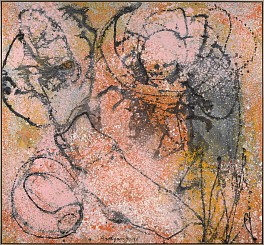BIOGRAPHY

1922-2008
GRACE HARTIGAN (1922-2008)
Raised in New Jersey, Grace Hartigan moved to California after she married in 1941 and then began drawing classes in Los Angeles. During World War II, Hartigan worked in Newark, New Jersey, as a draftsperson in an airplane factory and briefly studied painting with Isaac Lane Muse in New York. She met Mark Rothko and Adolph Gottlieb, and upon viewing Jackson Pollock’s 1948 exhibition at Betty Parsons Gallery, she began a series of gestural abstractions (1948-1952). Through Pollock, she met Willem de Kooning, a formative influence and friend.
Hartigan married and divorced several times and for a period of time exhibited under the name, “George Hartigan.” Her colorful canvases often challenged the non-objective tenets of Abstract Expressionism by including references to contemporary life: gritty market vendors, urban storefronts, still lifes, clothing, costumes, and masks. In her Matador series from the early 1950s, she played with sexual identity. She collaborated with poet Frank O’Hara on a series called Oranges, in which she incorporated words from his poems. Another series on bridal imagery, a subject examined throughout her oeuvre, addressed broader social dimensions of American womanhood, marriage, and consumerism. In 1956, she was the only woman included in Twelve Americans, at the Museum of Modern Art.
Four years later, she left the New York art world behind and moved to Baltimore with her last husband, Dr. Winston Price. She taught art at the Hoffberger School of Painting at the Maryland Institute College of Art and continued to paint for the rest of her life. In 2016, Hartigan was included in the seminal exhibition Women of Abstract Expressionism, curated by Dr. Gwen F. Chanzit and organized by the Denver Art Museum.
[Excerpt from the exhibition catalogue, "Women of Abstract Expressionism" published by Yale University Press in association with the Denver Art Museum]
